The Acer Swift 3 SF314 Notebook Review: Swift Gets Swifter With Ryzen 4000
by Brett Howse & Andrei Frumusanu on May 5, 2020 8:00 AM ESTSystem Performance
AMD’s new Renoir platform has already been showcased in our SPEC testing, which made a clear case that the new design provides a much-needed performance bump over the previous Picasso platform. Despite the individual cores having generally lower single-threaded performance than Intel’s Ice Lake, they make up for that deficiency with sheer volume, doubling the core count of the competition. AMD’s mantra for the entire Zen existence has been more for less, and that continues here again. Acer has positioned this laptop at an entry-level price, but with performance that should meet or exceed other devices in its class.
Both AMD based models of this 14-inch Acer Swift 3 come with 8 GB of RAM, in the DDR4-3200 flavor, which is where notebooks need to be these days for an entry position, so it was nice to see them offer 8 GB on both the Ryzen 5 and Ryzen 7 models. The company could have cut back to hit an even lower price point, especially on the Ryzen 5, but that would impact the performance too much to make it a worthwhile compromise. They’ve also started with a 256 GB SSD on the Ryzen 5 model, and bumped that up to 512 GB on the Ryzen 7 we have here, and still at just $649, which is fantastic value and should keep the target market happy for some time.
To see how the Acer Swift 3 with Ryzen 7 4700U performs, we have run it through our laptop test suite and compared it to several other similar systems. If you'd like to compare the Acer Swift 3 to any other laptop we have tested, please check out our online Bench.
PCMark
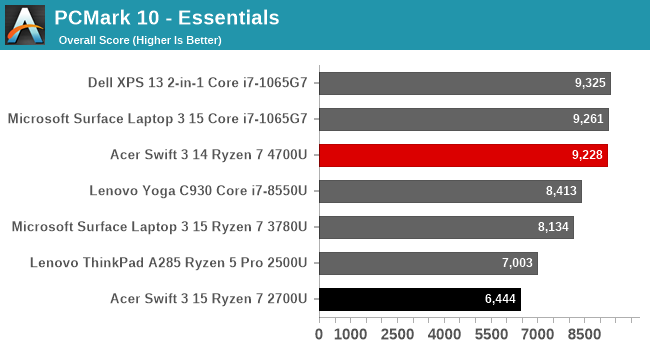
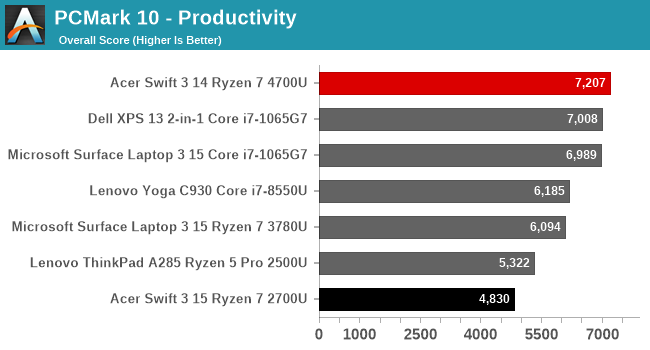
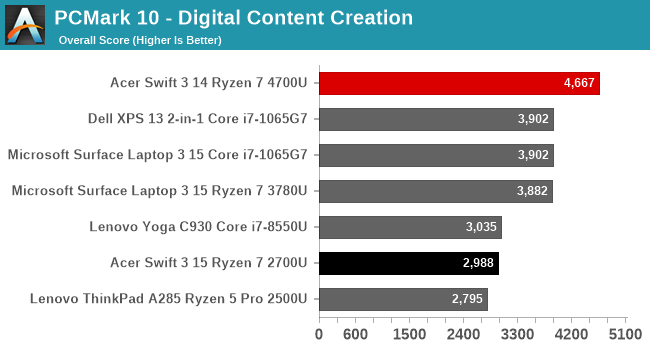
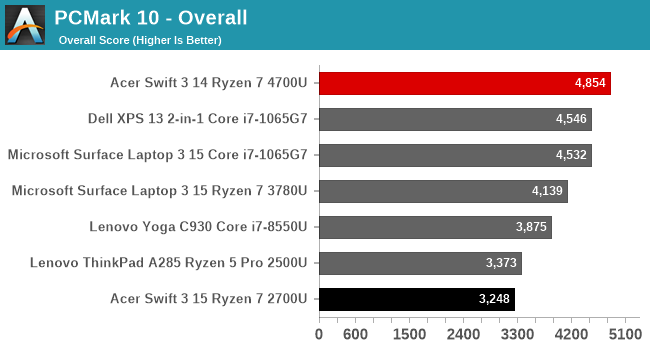
UL’s PCMark suite offers some real-world test cases, and tests all aspects of the system, from CPU performance, to GPU, to even app-loading times and disk performance. The Acer Swift 3 performs very well here, especially in the digital content creation sub-tests, where the GPU gets to showcase some of its prowess.
Cinebench R20
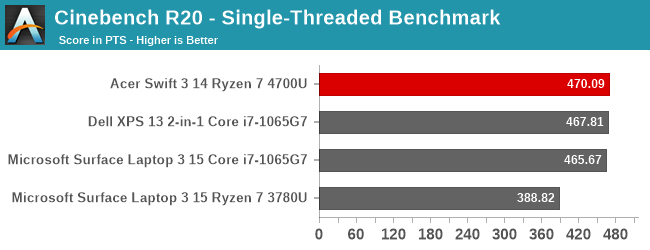
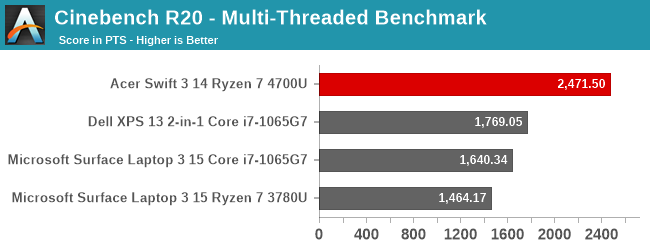
AMD has been touting its Cinebench results for some time since their launch of Zen, and for good reason. As a compute-focused test, the Zen 2 cores perform very well here, and having eight physical cores in the multithreaded results really make the Ryzen 7 4700U stand out. SMT has been a great way to get more performance per-core, but there is still no substitute for actual cores.
x264

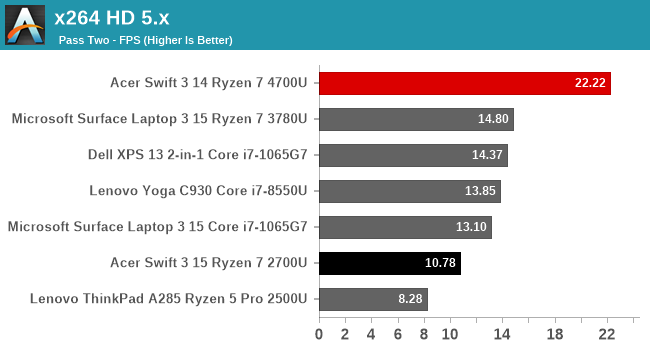
The x264 test transcodes a video using the CPU and has always enjoyed more CPU performance and more CPU cores, so it should not surprise anyone that the Ryzen 7 4700U wins the day here again. Eight cores make short work of this transcode.
Handbrake
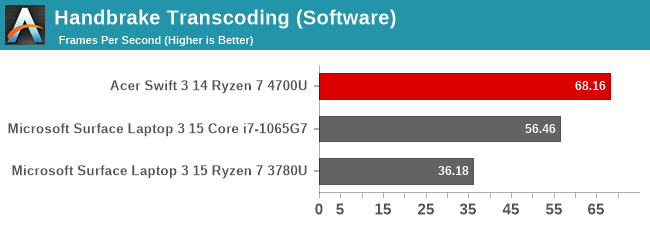

Handbrake is arguably the most popular video transcode tool around, and it offers both software-based CPU transcoding, as well as GPU accelerated. On our last Picasso platform, the Microsoft Surface Laptop 3, Handbrake wasn’t able to leverage Vega’s Video Core Next hardware, however the Acer Swift 3 can, and in both software and hardware encoding, the Renoir based Acer Swift 3 finishes this task very quickly.
7-Zip
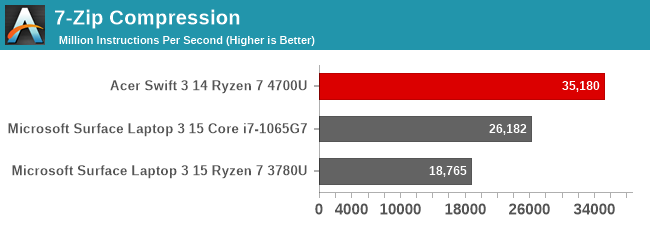
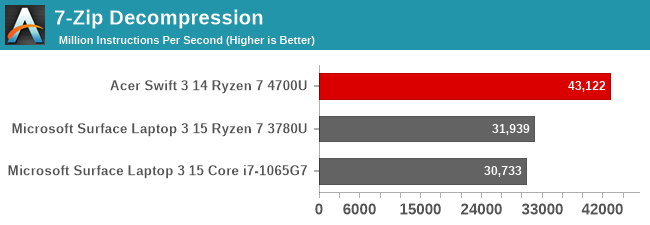
7-Zip is a very popular, free file compression and extraction tool, and it also offers a built-in benchmark. AMD’s Renoir SoC once again outperforms the rest of the 15-Watt systems here. Tests such as this and transcode do very well with the extra cores provided on the Ryzen 7 4700U.
Web Benchmarks
This will likely be our last review with the older web tests. Web benchmarks are as much about the browser’s scripting engine as they are about pure CPU performance, so for consistency we’ve tested in Microsoft Edge. Now that Edge is being moved to the new Chromium-based version, we’ll take this opportunity to replace some of our older tests.
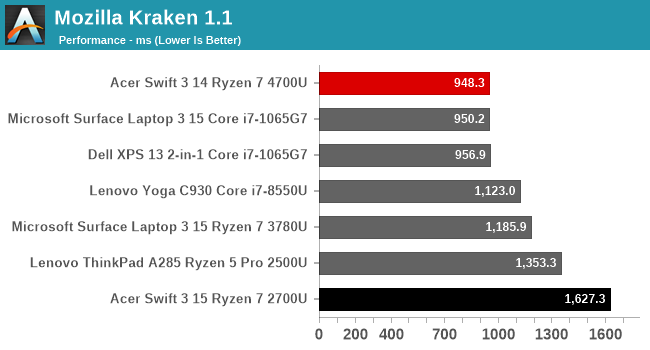
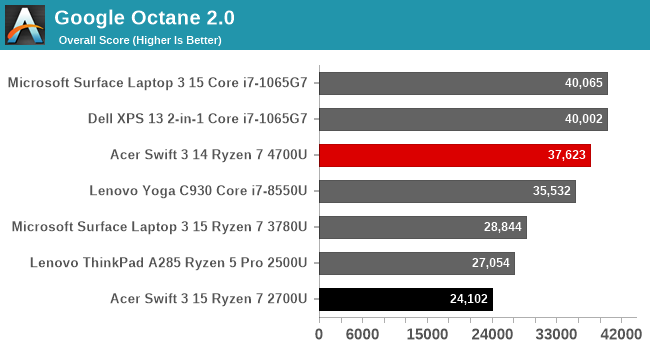
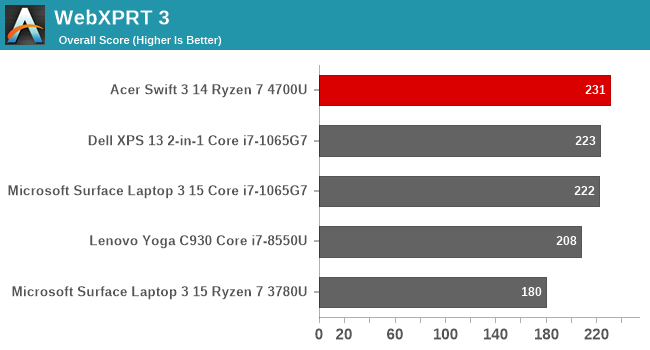
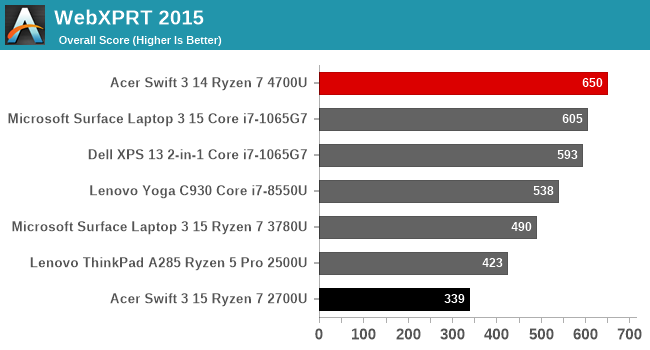
Web tests also tend to be more sensitive to the CPU being able to ramp up its frequency quickly, and that is an area where AMD’s systems did not perform quite as well. Luckily for Renoir, those issues are behind AMD, and the Acer Swift 3 performs very well.
Storage
One of the best things about the Acer Swift 3 is how much storage it comes with considering its price point. The review unit offers 512 GB of SSD storage, and although you may expect slower, cheaper SATA storage here, that is not the case. The Acer Swift 3 ships with NVMe PCIe 3.0 x4 storage, and in the case of the review unit, that means a Samsung PM991 SSD inside.
Performance is excellent. Despite this being a budget notebook, the storage options are very welcome. A base model offering 256 GB is a great start, but a proper NVMe SSD as well makes this laptop even more value.
System Performance Conclusion
Although AMD has really made inroads in the desktop space since the launch of Zen, in the laptop space where power is at a premium, what made the early Zen based APUs stand out was not the CPU but the GPU. Since then, Intel released Ice Lake, offering similar GPU performance but with much higher CPU performance. Now that AMD is on their third-generation of Zen-based laptop APUs, that performance lead has all but evaporated. In our SPEC results, Intel still has the single-threaded lead, but AMD more than makes up for that by offering eight CPU cores, compared to just four on Ice Lake. The Ryzen 7 4700U that Acer has fitted into this Swift 3 is likely to be one of the more popular options, and for good reason. Despite it not offering SMT, the performance is fantastic.


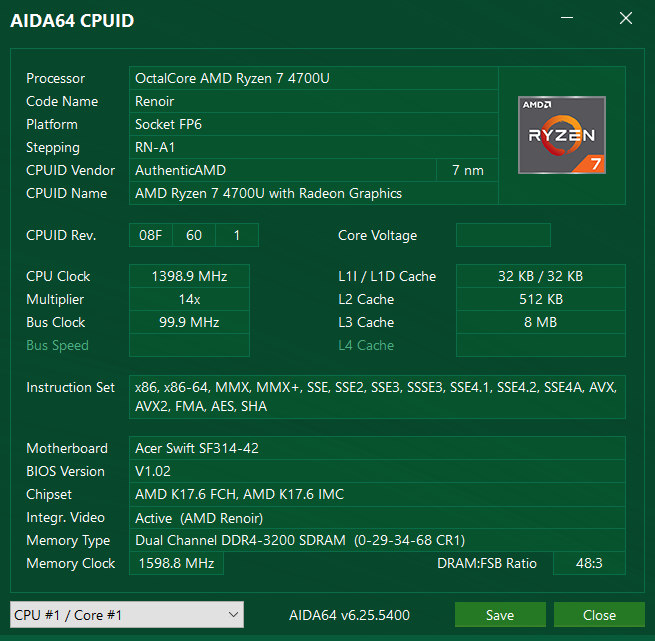









191 Comments
View All Comments
lightningz71 - Tuesday, May 5, 2020 - link
It appears that the Acer Swift design philosophy just doesn't translate for anything that requires a high steady-state power draw and thermal load. The Swift had the same issues with the 2XXX and 3XXX series chips as well, so this is nothing new. This is something that Acer has deliberately chosen to make a design trade-off for: sacrifice some thermal dissipation ability to keep the product in the size class that it is intended for.It will be interesting to see the benchmarks on the 4500U in this platform. It was shown in benchmarks of previous versions of the swift that lower end APUs actually performed better in gaming than the top end parts because the system was better able to manage the thermal output and the APU was better able to keep consistent clocks. While the absolute performance was still lower than notebooks with better thermal management implementations, it was a better gaming performer than the top end SKU.
neblogai - Tuesday, May 5, 2020 - link
Generally, you are not complaining about Acer, but about U-series chips from both Intel or AMD. The philosophy of laptops with ~15W chips is that these chips are used in ultrabooks that are responsive and fast in short boosts, and not made for steady power (even if there are some premium devices that offer both).fmcjw - Tuesday, May 5, 2020 - link
The 2019 Swift 5 and LG Gram series were matched to the thermal promises of Intel 10nm chips that took 2 generations to arrive, and maybe 5nm AMD SoCs in 2021 since AMD decided to rush to market with last generation GPU architecture in early 2020. Perhaps with software or AI based optimization, there can be a more optimal mix of processes split between the CPU versus the GPU for best performance within thermal constraints. Not every task is as clear cut as gaming routines, where more of the work is performed more efficiently on the GPU. I'm not sure that will happen though, as such software optimization has the least return on investment outside cloud and data center applications. Not even Apple wants to do it for the 2020 Macbook Air, thermally crippling a fine Intel chip and resolving the issue by sticking a more powerful cooling solution in a Macbook Pro (and charge more).For 2020, Acer managed to get the Swift 3 down to 1.2kg from 1.45kg of the 2019 model through the use of aluminum AND magnesium (not just aluminum as the article states). The 2020 Swift 5 maintains a 1kg weight while including a rare-breed matte touch screen. The Swift 5 is the model you want to get for 100% sRGB at a $300 premium. I think the only reason these fine machines sell for $600 to $900 for a mid-range configuration is the thermally constrained performance of the more stubbornly ambitious SoCs.
Which if they can think outside the box can easily resolve by selling a fan-assisted cooling dock and unleash the full potential of the SoC we already paid for (and charge more).
Fulljack - Tuesday, May 5, 2020 - link
while Vega here is based on GCN 5 and not RDNA, it doesn't mean it's an outdated architecture. AMD did enhance the Vega arch for Ryzen 4000, with 56% improvement over Vega arch found in Ryzen 3000. overall, with enhanced arch, reduced core count, and higher clock, AMD did deliver 2020 Vega 8 that performs 28% better than 2019 Vega 11.https://www.anandtech.com/show/15324/amd-ryzen-400...
Oxford Guy - Thursday, May 7, 2020 - link
All irrelevant when the laptop's cooling is so pathetic:"The laptop really struggled with its thermals, dropping the framerate into single digits often. The device attempted to run at around 18 Watts of power draw, slightly over the 15 Watt TDP, but in fact only averaged around 8 Watts during this run."
csp4me - Tuesday, May 5, 2020 - link
Acer Swift 3 and 5 are in the market for lightweight, cool & quiet laptops within thermal constraints, thus ~ 18W tdp, and throttling under stress test.For the same budget of Acer Swift 5 ~ $900 you can find laptop models with the same quality display or better and also better thermals ~ 28W-35W at the expense of weight 1.3-1.4kg and noise/heat during heavy loads. Examples Lenovo Ideapad S540-13 both AMD or Intel, or Yoga Slim 7 both AMD or Intel.
psychobriggsy - Tuesday, May 5, 2020 - link
When you buy low power laptops - Y or U series TDPs - you are really looking out for these things1) Sustained Single Core Clock
2) Sustained All-Core Clock
3) Race-To-Sleep Single Core Turbo Boost (and the time it can sustain this)
4) Race-To-Sleep All-Core Turbo Boost (and the time it can sustain this)
1 and 2 are what your gaming sessions will occur in. 3 and 4 might help in some particularly CPU-heavy parts, but only for small periods of time.
This is the problem Intel have with their 14++++ chips - 1 and 2 cannot be raised in the TDP they are restricted to (unlike desktop, where they can simply lie about the figures, in a laptop this will affect battery life and be easily detected), so they hype 3 and 4 to compensate.
AMD on 7nm does well in all four measures, but you should never think you'll get long-term turbo clock performance from any mobile chip. I don't know if Renoir has a 4C turbo that can last longer than the 8C turbo for lightly threaded loads.
fmcjw - Tuesday, May 5, 2020 - link
Can a Y or U series SoC be considered the equivalent of an H series SoC internally, with a beefier cooling solution and reduced I/O capabilities externally? I imagine not just the I/O or cooler but also the capacitors and power circuitry need to be higher specified for the higher sustained load.It's just that few makers even try to create a balanced system around the U or Y series, letting Turbo Boost go wild to impress for the first minute or two, or restraint the system thermally to achieve longer battery life even when you can plug it in.
T1beriu - Tuesday, May 5, 2020 - link
>the mobile chips here only feature half the L3 cache compared to its desktop counterpartsSmall correction. Ryzen 4000 actually has a quarter.
ads295 - Tuesday, May 5, 2020 - link
Acer has consistently impressed me with their attention to detail. There are so many moronic OEMs that put in a single module of RAM but even my 2016 Acer E5-553-T4PT came with 2 modules of 2GB DDR4 RAM to enable the A10-9600P to run in dual channel mode.I suppose they don't get paid to debilitate AMD setups.